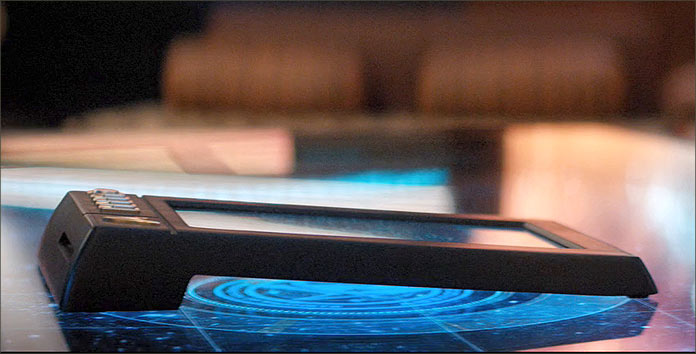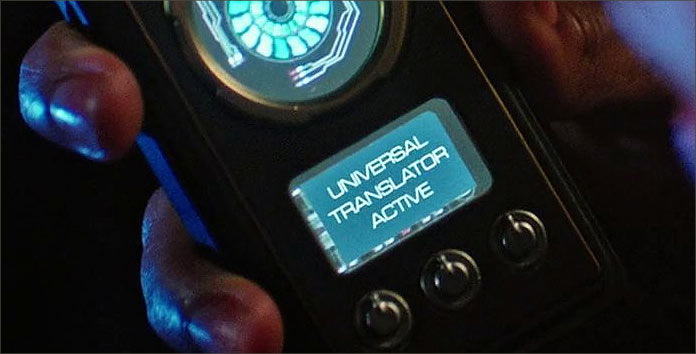“An Obol for Charon” and “Saints of Imperfection” were two acting masterclasses from Doug Jones, Mary Wiseman, Anthony Rapp, and Wilson Cruz, framed around the Discovery experiencing technical difficulties due to an encounter with a planet-sized lifeform and a dark journey into the mysterious mycelial network.
The episodes gave us a fun new technical challenge – a malfunctioning universal translator – that we had never really seen before in Star Trek, laid down new lore for Section 31, and more, along with giving us plenty of references to the previous canon, including the return of a fan favorite character not seen on screen in five decades.
Let’s dive in!
Number One

Returning to the franchise for the first time since 1965 is the character of Number One, the executive officer aboard the USS Enterprise. Played originally by Majel Barrett, the Discovery-era interpretation of the character is played by Rebecca Romjin.
Though we only get to see the character for one scene in “Obol,” more appearances are likely.
That Damned Holographic Comm System

Pike instructs Number One to remove the holographic communications system from the Enterprise. “I never much liked the damn thing anyway,” he tells her. Assuming the system is not restored to the ship, it explains why we never saw holographic communications aboard the Enterprise in the Original Series.
Perhaps the problems experienced with the system aboard the Enterprise later spread to the rest of the fleet, explaining why the technology was later considered “new” again in the 24th century.
Classic 23rd Century Design

Number One beams aboard with a large PADD, very similar in style to the clipboard-sized data slates seen in the Original Series – though with seemingly more functionality than those devices were shown to have, thanks to the advances in real-world technology since the 1960s.
Fun with Foreign Languages

Contact with the unknown sphere causes the Universal Translator on Discovery to malfunction, rendering the speech of the crew into multiple different languages. In addition to a number of Earth languages, Klingon and Andorian are also heard.
Detmer also points out that her controls are rendered in the language of Tau Ceti, the home star system for the freighter Kobyashi Maru (Star Trek II: The Wrath of Khan), and Jean-Luc Picard introduced Jack Crusher to Beverly Howard on Tau Ceti III (“Conspiracy”).
EPS Grid

The virus infecting Discovery causes the EPS conduits to overload, the first reference in Discovery to the electro-plasma distribution network, the primary means of distributing energy throughout a starship.
Cortical Implant

To be able to communicate with the mycelial lifeform that was manifesting to Tilly as May, Stamets and Reno develop a plan to place a cortical implant into Tilly’s brain. Cortical implants are a technology used by the Borg, and in the 24th century were used by the Breen to probe the mind of prisoners.
Eject the warp core!

In order to escape the lifeform’s hold on Discovery, Pike orders Detmer to eject and detonate the warp core. At various points in Star Trek history, notably in “Star Trek: Insurrection,” “Day of Honor,” and “Renaissance Man,” the warp core has been ejected, normally to avoid a warp core breach destroying the ship.
Medkit

In order to snap out of a hallucinogenic trip caused by the Jah’Sepp cocoon, Stamets reaches into the Engineering medkit for a hypospray. Though we have seen plenty of sickbay scenes since the start of Discovery, this is the first call out to the medkit specifically in the show.
Cestus III

After capturing Spock’s shuttle in the opening of “Saints of Imperfection,” which was being piloted by Emperor Georgiou, Captain Pike is confronted by her superior in Section 31 – Leland. Pike and Leland clearly have a pre-existing relationship, as Pike says the last time he saw Leland was “wrestling alligators on Cestus III.”
Cestus III is the site of a Federation colony that would later be destroyed by the Gorn in the Original Series episode “Arena.”
Hyronalin

As Pike tells Burnham about Tyler’s assignment to the Discovery by Section 31 in “Saints of Imperfection,” an intercom message reminds the crew that they need to ensure they have had their hyronalin treatments – a drug seen a number of times during the Star Trek franchise (first referenced in The Original Series episode “The Deadly Years”) as a medicine used to counter the effects of radiation sickness.
Type III Phaser Rifle

“I’m holding a Type III phaser rifle. It is more powerful and generally larger than the Type I or Type II, which I guess is why they call it a three,” Tilly tells May of the phaser rifle she is carrying as they walk through the corridors of Discovery after it breaks through into the mycelial network in “Saints of Imperfection.”
The term “Type III” to identify the rifle-style weapon was first used in Voyager’s “Phage.”
“What Kind of Communicator is That?”

With Discovery at risk of sinking fully into the mycelial network and killing members of its crew in “Saint of Imperfection,” Tyler reveals that the Section 31 black badges are actually chest communicators — precursors to the familiar commbadges worn by Starfleet officers in the 24th century.
Deneva

As Georgiou works to convince Leland to try to maintain their tractor beam longer to prevent Discovery from falling into the mycelial network in “Saints of Imperfection,” she tells him she knows he made a mistake involving the “wrong ambassador” on Deneva.
Deneva is a Federation planet first seen in The Original Series episode “Operation – Annihilate!” and is referenced in Deep Space Nine and Enterprise.
Article 14, Section 31

Pike beams aboard the Section 31 ship at the end of “Saints of Imperfection” to meet with Admiral Cornwell and Leland. Cornwell tells Pike that “we have more pressing priorities than debating Article 14 of Starfleet’s charter.”
She is referring to the section of the Starfleet charter that authorized the creation of Section 31, which is a call back to the Enterprise episode “Divergence” where Harris also cites the same reference to the charter.
Tachyons

In the same scene at the end of “Saints of Imperfection,” Cornwell tells Pike and Leland that the red signals leave behind a tachyon signal. They theorize that the presence of tachyons could imply the involvement of time travel.
Tachyons are a frequent cosmic byproduct of time travel, as seen in episodes like Voyager’s “Future’s End, Part I and II,” “Fury,” “Endgame,” and Enterprise’s “Cold Front.”
[td_smart_list_end]
![]()
We’ll be back with more Canon Connections after the next few Star Trek: Discovery outings, this week’s “The Sounds of Thunder” and next week’s “Light and Shadows.”
